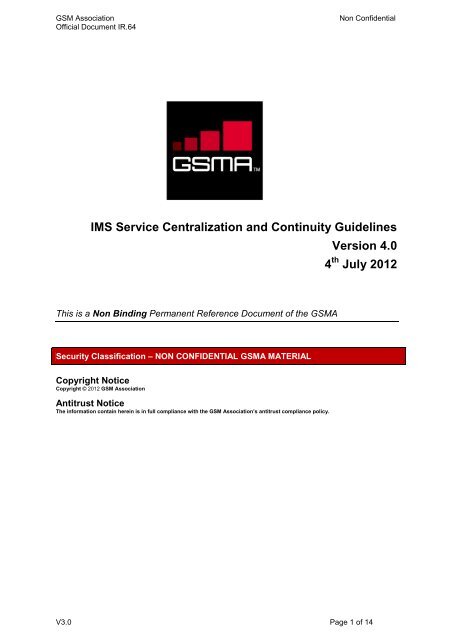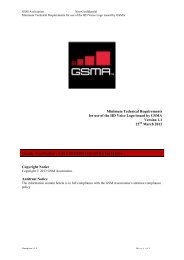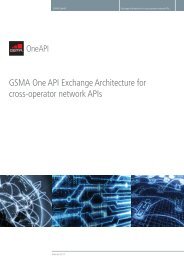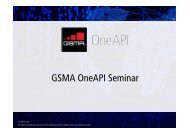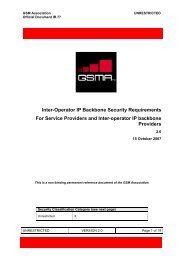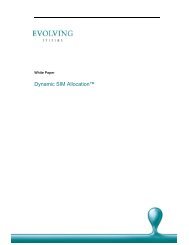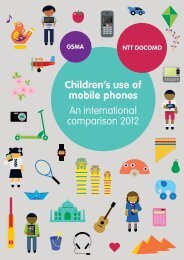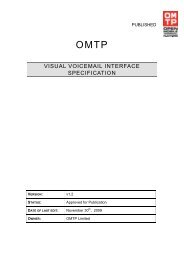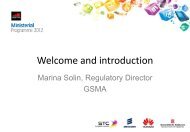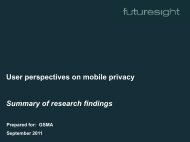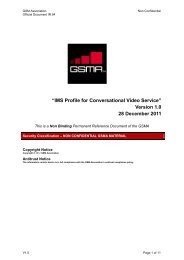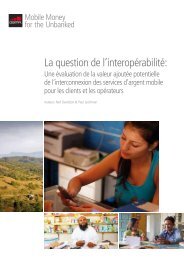IR.64 "IMS Service Centralization and Continuity Guidelines" - GSMA
IR.64 "IMS Service Centralization and Continuity Guidelines" - GSMA
IR.64 "IMS Service Centralization and Continuity Guidelines" - GSMA
Create successful ePaper yourself
Turn your PDF publications into a flip-book with our unique Google optimized e-Paper software.
GSM Association<br />
Official Document <strong>IR.64</strong><br />
Non Confidential<br />
<strong>IMS</strong> <strong>Service</strong> <strong>Centralization</strong> <strong>and</strong> <strong>Continuity</strong> Guidelines<br />
Version 4.0<br />
4 th July 2012<br />
This is a Non Binding Permanent Reference Document of the <strong>GSMA</strong><br />
Security Classification – NON CONFIDENTIAL <strong>GSMA</strong> MATERIAL<br />
Copyright Notice<br />
Copyright © 2012 GSM Association<br />
Antitrust Notice<br />
The information contain herein is in full compliance with the GSM Association’s antitrust compliance policy.<br />
V3.0 Page 1 of 14
GSM Association<br />
Official Document <strong>IR.64</strong><br />
Non Confidential<br />
Table of Contents<br />
1 Introduction 3<br />
1.1 Overview 3<br />
1.2 Scope 3<br />
1.3 Definition of Terms 3<br />
1.4 Document Cross-References 4<br />
2 <strong>Service</strong> <strong>Centralization</strong> in the <strong>IMS</strong> 5<br />
2.1 General 5<br />
2.1.1 Anchoring when using PS access 5<br />
2.1.2 Anchoring when using CS access 5<br />
3 Terminated Access Domain Selection 7<br />
4 SRVCC 8<br />
4.1 General 8<br />
4.2 Impacted entities 8<br />
4.3 SRVCC Architecture 9<br />
4.3.1 Overview 9<br />
4.4 Support of mid-call state <strong>and</strong> calls in alerting state 11<br />
4.4.1 Overview 11<br />
4.4.2 UE impacts 11<br />
4.4.3 Network impacts 11<br />
4.5 SRVCC Architecture for emergency calls 11<br />
4.5.1 UE impacts 12<br />
4.5.2 Network impacts 12<br />
4.6 H<strong>and</strong>ling of non-voice media during SRVCC 12<br />
Document Management 13<br />
Document History 13<br />
Other Information 14<br />
V3.0 Page 2 of 14
GSM Association<br />
Official Document <strong>IR.64</strong><br />
Non Confidential<br />
1 Introduction<br />
1.1 Overview<br />
The 3rd Generation Partnership Project (3GPP) has specified the solution for centralization<br />
of services in the IP Multimedia Subsystem (<strong>IMS</strong>) <strong>and</strong> of <strong>IMS</strong> based service continuity in<br />
Release 8 onwards. The user shall receive services in a consistent manner when the user<br />
accesses <strong>IMS</strong> either via the Circuit Switched (CS) or the Packet Switched (PS) domain.<br />
<strong>Service</strong> continuity is supported between CS <strong>and</strong> PS domains.<br />
1.2 Scope<br />
This document provides guidelines for the centralization of <strong>IMS</strong> services <strong>and</strong> <strong>IMS</strong> based<br />
service continuity for single radio devices [3] by listing a number of Evolved Packet Core,<br />
<strong>IMS</strong> core, <strong>and</strong> User Equipment (UE) features on top of the features defined in [11]. The<br />
defined guidelines are compliant with 3GPP specifications. Guidelines are provided for the<br />
interface between UE <strong>and</strong> network <strong>and</strong> for the network architecture. The centralization of<br />
<strong>IMS</strong> services is focused on the network based solution; the UE based <strong>IMS</strong> Centralized<br />
<strong>Service</strong>s (ICS) solution is out of scope of this document <strong>and</strong> not recommended. <strong>IMS</strong> based<br />
service continuity is focused on Single Radio Voice Call <strong>Continuity</strong> (SRVCC) from E-UTRAN<br />
(Evolved Universal Terrestrial Radio Access Network) to GERAN/UTRAN <strong>and</strong> from HSPA<br />
(High Speed Packet Access) to GERAN/UTRAN; other service continuity scenarios are out<br />
of scope.<br />
UE impacts of each feature are described in a separate subsection where applicable.<br />
1.3 Definition of Terms<br />
Term<br />
3GPP<br />
ATCF<br />
ATGW<br />
BGCF<br />
CN<br />
CS<br />
CSCF<br />
DTM<br />
eNB<br />
EPS<br />
EATF<br />
EDGE<br />
E-CSCF<br />
E-UTRAN<br />
GERAN<br />
GGSN<br />
GSM<br />
HSPA<br />
HSS<br />
ICS<br />
iFC<br />
IMRN<br />
<strong>IMS</strong><br />
<strong>IMS</strong> AGW<br />
LTE<br />
MGCF<br />
MGW<br />
Description<br />
3 rd Generation Partnership Project<br />
Access Transfer Control Function<br />
Access Transfer Gateway<br />
Breakout Gateway Control Function<br />
Core Network<br />
Circuit Switched<br />
Call Session Control Function<br />
Dual Transfer Mode<br />
eNodeB<br />
Evolved Packet System<br />
Emergency Access Transfer Function<br />
Enhanced Data rates for GSM Evolution<br />
Emergency CSCF<br />
Evolved Universal Terrestrial Radio Access Network<br />
GSM/EDGE Radio Access Network<br />
Gateway GPRS Support Node<br />
Global System for Mobile communications<br />
High Speed Packet Access<br />
Home Subscriber Server<br />
<strong>IMS</strong> Centralized <strong>Service</strong>s<br />
Initial Filter Criteria<br />
<strong>IMS</strong> Routing Number<br />
IP Multimedia Subsystem<br />
<strong>IMS</strong> Access Gateway<br />
Long Term Evolution<br />
Media Gateway Control Function<br />
Media Gateway<br />
V3.0 Page 3 of 14
GSM Association<br />
Official Document <strong>IR.64</strong><br />
Non Confidential<br />
MMTel<br />
MS<br />
MSC<br />
MS-ISDN<br />
PCC<br />
PCRF<br />
P-CSCF<br />
PS<br />
QCI<br />
RAT<br />
RAU<br />
RTP<br />
SCC AS<br />
S-CSCF<br />
SGSN<br />
SIP<br />
SRVCC<br />
TAS<br />
TAU<br />
TrGW<br />
UE<br />
UTRAN<br />
Multimedia Telephony<br />
Mobile Station<br />
Mobile Switching Centre<br />
Mobile Subscriber ISDN Number<br />
Policy <strong>and</strong> Charging Control<br />
Policy <strong>and</strong> Charging Rules Function<br />
Proxy – CSCF<br />
Packet Switched<br />
Quality of <strong>Service</strong> Class Indicator<br />
Radio Access Technology<br />
Routing Area Update<br />
Real Time Protocol<br />
<strong>Service</strong> <strong>Centralization</strong> <strong>and</strong> <strong>Continuity</strong> Application Server<br />
Serving CSCF<br />
Serving GPRS Support Node<br />
Session Initiation Protocol<br />
Single Radio Voice Call <strong>Continuity</strong><br />
Telephony Application Server<br />
Tracking Area Update<br />
Transition Gateway<br />
User Equipment<br />
Universal Terrestrial Radio Access Network<br />
1.4 Document Cross-References<br />
Ref<br />
1<br />
Document<br />
Number<br />
3GPP TS 23.060<br />
Title<br />
General Packet Radio <strong>Service</strong> (GPRS); <strong>Service</strong> description;<br />
Stage 2<br />
2 3GPP TS 23.167 IP Multimedia Subsystem (<strong>IMS</strong>) emergency sessions<br />
3 3GPP TS 23.216 Single Radio Voice Call <strong>Continuity</strong> (SRVCC); Stage 2<br />
4 3GPP TS 23.237 IP Multimedia Subsystem (<strong>IMS</strong>) <strong>Service</strong> <strong>Continuity</strong>; Stage 2<br />
5 3GPP TS 23.292 IP Multimedia Subsystem (<strong>IMS</strong>) centralized services, Stage 2<br />
6<br />
3GPP TS 23.401 General Packet Radio <strong>Service</strong> (GPRS) enhancements for Evolved<br />
Universal Terrestrial Radio Access Network (E-UTRAN) access<br />
7<br />
3GPP TS 24.008 Mobile radio interface layer 3 specification; Core Network<br />
protocols; Stage 3<br />
8 3GPP TS 24.237 IP Multimedia Subsystem (<strong>IMS</strong>) <strong>Service</strong> <strong>Continuity</strong>; Stage 3<br />
9<br />
3GPP TS 29.292<br />
Interworking between the IP Multimedia (IM) Core Network (CN)<br />
subsystem <strong>and</strong> MSC Server for <strong>IMS</strong> Centralized <strong>Service</strong>s (ICS)<br />
10 3GPP TS 23.221 Architectural requirements<br />
11 <strong>GSMA</strong> PRD IR.92 <strong>IMS</strong> Profile for Voice <strong>and</strong> SMS<br />
12 3GPP TS 23.203 Policy <strong>and</strong> charging control architecture<br />
13 3GPP TS 23.228 IP Multimedia Subsystem (<strong>IMS</strong>); Stage 2<br />
14 3GPP TS 29.205<br />
15 3GPP TS 29.163<br />
Application of Q.1900 series to bearer independent Circuit<br />
Switched (CS) core network architecture; Stage 3<br />
Interworking between the IP Multimedia (IM) Core Network (CN)<br />
subsystem <strong>and</strong> Circuit Switched (CS) networks<br />
16 <strong>GSMA</strong> PRD IR.94 <strong>IMS</strong> Profile for Conversational Video <strong>Service</strong><br />
17 <strong>GSMA</strong> PRD IR.58 <strong>IMS</strong> Profile for Voice over HSPA<br />
18 <strong>GSMA</strong> PRD IR.65 <strong>IMS</strong> Roaming & Interworking Guidelines<br />
V3.0 Page 4 of 14
GSM Association<br />
Official Document <strong>IR.64</strong><br />
Non Confidential<br />
2 <strong>Service</strong> <strong>Centralization</strong> in the <strong>IMS</strong><br />
2.1 General<br />
3GPP has specified in [4] <strong>and</strong> [5] the principles for centralization <strong>and</strong> continuity of services<br />
in the <strong>IMS</strong> in order to provide consistent services to the user regardless of the attached<br />
access type. In order to support this principle, originated <strong>and</strong> terminated sessions via the<br />
CS or PS domains need to be anchored in the <strong>Service</strong> <strong>Centralization</strong> <strong>and</strong> <strong>Continuity</strong><br />
Application Server (SCC AS) in the <strong>IMS</strong>. The SCC AS must be inserted in the session path<br />
using originating <strong>and</strong> terminating initial Filter Criteria (iFC) [13]; it is configured as the first<br />
AS in the originating iFC <strong>and</strong> as the last AS in the terminating iFC chain.<br />
2.1.1 Anchoring when using PS access<br />
The SCC AS anchors originated <strong>and</strong> terminated sessions when using the PS access as<br />
specified in [4].<br />
2.1.2 Anchoring when using CS access<br />
The SCC AS anchors originated <strong>and</strong> terminated sessions when using the CS access as<br />
specified in [5]. Originated sessions are routed from the Mobile Switching Centre (MSC)<br />
Server enhanced for ICS in the VPLMN to the Serving Call Session Control Function (S-<br />
CSCF) in the Home Public L<strong>and</strong> Mobile Network (HPLMN) <strong>and</strong> the SCC AS <strong>and</strong> the<br />
Telephony Application Server (TAS) are invoked, that is the SCC AS is the first invoked AS<br />
(see also Figure 2.1.2-1). Terminating sessions are routed to the S-CSCF <strong>and</strong> the TAS <strong>and</strong><br />
the SCC AS are invoked before routing the session to the MSC Server in the VPLMN, that<br />
is the SCC AS is the last invoked AS. The interworking between the <strong>IMS</strong> <strong>and</strong> the MSC<br />
Server enhanced for ICS for originated, terminated <strong>and</strong> mid-call services is specified in [9].<br />
Ut/XCAP<br />
ICS<br />
Sh<br />
MSC-S works as<br />
<strong>IMS</strong> UA<br />
towards <strong>IMS</strong><br />
ICS<br />
HSS<br />
ICS<br />
T-ADS<br />
SCC<br />
AS<br />
ISC<br />
TAS<br />
ISC<br />
24.008 I2<br />
MSC-S<br />
ICS<br />
CSCF<br />
SIP<br />
CS<br />
MGW<br />
Mb/RTP<br />
Remote<br />
End<br />
Serving PLMN<br />
HPLMN<br />
ICS<br />
Functionality<br />
Figure 2.1.2-1: Anchoring in the <strong>IMS</strong> when using MSC Server enhanced for ICS<br />
In deployments not using the MSC Server enhanced for ICS, originated <strong>and</strong> terminated<br />
services are also provided in the <strong>IMS</strong>, but mid-call <strong>and</strong> presentation services must be<br />
provided in the subscriber data sent to the MSC such that the MSC can provide these<br />
services, see section 7.6.3 of [5]. 3GPP describes in [5] how to route originated sessions<br />
from the MSC to the <strong>IMS</strong> by fetching an <strong>IMS</strong> Routing Number (IMRN) via CAMEL <strong>and</strong> how<br />
to route terminated session from the <strong>IMS</strong> to the MSC. Originated sessions are routed from<br />
V3.0 Page 5 of 14
GSM Association<br />
Official Document <strong>IR.64</strong><br />
Non Confidential<br />
the MSC Server in the VPLMN via a Media Gateway Control Function (MGCF) in the<br />
HPLMN to the S-CSCF <strong>and</strong> the SCC AS <strong>and</strong> the Telephony Application Server (TAS) are<br />
invoked (see also Figure 2.1.2-2). The MSC needs to fetch a routing number from the<br />
<strong>Service</strong> Control Point (SCP).<br />
Ut/XCAP<br />
ICS<br />
Sh<br />
MME/<br />
SGSN<br />
HSS<br />
ICS<br />
T-ADS<br />
CAP v2<br />
SCP<br />
SCC<br />
AS<br />
ISC<br />
TAS<br />
ISC<br />
24.008 ISUP<br />
Mg/SIP<br />
SIP<br />
MSC<br />
MGCF<br />
CSCF<br />
CS<br />
CS<br />
MGW<br />
Mb/RTP<br />
Remote<br />
End<br />
Serving PLMN<br />
HPLMN<br />
ICS<br />
Functionality<br />
Figure 2.1.2-2: Anchoring in the <strong>IMS</strong> when using MSC not enhanced for ICS:<br />
origination<br />
In deployments where Integrated <strong>Service</strong>s Digital Network User Part (ISUP) does not<br />
provide original called number <strong>and</strong> calling party number, the SCC AS needs to discover this<br />
information by interacting with the SCP (for example GSM <strong>Service</strong> Control Function<br />
(gsmSCF)). The interaction between SCP <strong>and</strong> SCC AS for this purpose is not specified in<br />
3GPP, see section 7.3.2.1.3 of [5].<br />
Terminating sessions are routed to the S-CSCF <strong>and</strong> the TAS <strong>and</strong> the SCC AS are invoked<br />
before routing the session via Breakout Gateway Control Function (BGCF) (not shown) <strong>and</strong><br />
Media Gateway Controller Function (MGCF) in the HPLMN to the MSC in the VPLMN (see<br />
also Figure 2.1.2-3).<br />
V3.0 Page 6 of 14
GSM Association<br />
Official Document <strong>IR.64</strong><br />
Non Confidential<br />
Ut/XCAP<br />
ICS<br />
Sh<br />
MME/<br />
SGSN<br />
HSS<br />
T-ADS<br />
ICS<br />
SCC<br />
AS<br />
ISC<br />
TAS<br />
ISC<br />
24.008 ISUP<br />
Mg/SIP<br />
SIP<br />
MSC<br />
GMSC<br />
MGCF<br />
CSCF<br />
CS<br />
CS<br />
MGW<br />
Mb/RTP<br />
Remote<br />
End<br />
Serving PLMN<br />
HPLMN<br />
ICS<br />
Functionality<br />
Figure 2.1.2-3: Anchoring in the <strong>IMS</strong> when using MSC not enhanced for ICS:<br />
termination<br />
Solutions for routing a terminated session from the Public Switched Telephone Network<br />
(PSTN) domain to the <strong>IMS</strong> are described in [5], Annex F.<br />
CS emergency calls <strong>and</strong> SMS are not centralized in the <strong>IMS</strong>, that is, they are h<strong>and</strong>led as<br />
CS service when camping on CS access.<br />
Note: That CS data <strong>and</strong> fax have been included in Release 10 into [5] but are out of scope<br />
of this document.<br />
3 Terminated Access Domain Selection<br />
Terminating Access Domain Selection (T-ADS) selects CS access or PS access network(s)<br />
to be used to deliver a terminating voice session to the UE. In 3GPP [4,5], also the case of<br />
selecting multiple PS accesses is covered, however, this use case is out scope of this<br />
document. T-ADS is a functionality located in the <strong>IMS</strong> in the SCC AS <strong>and</strong> specified in [4,5]<br />
<strong>and</strong> must be present in any deployment in which <strong>IMS</strong> Voice over Internet Protocol (VoIP)<br />
capable radio coverage is complemented with the CS radio access for voice.<br />
In order to accurately determine whether to route to CS or PS access, the SCC AS must<br />
know whether the UE that is registered in the <strong>IMS</strong> is currently camping on an <strong>IMS</strong> Voice<br />
over PS capable access (for example on E-UTRAN). For this purpose, network-based T-<br />
ADS has been specified in [1,4,6,10] in 3GPP Release 9. It adds the capability to the SCC<br />
AS to query the Home Subscriber Server (HSS) for the <strong>IMS</strong> Voice over PS supported<br />
indication. If the subscriber is registered in both Serving GPRS Support Node (SGSN) <strong>and</strong><br />
Mobility Management Entity (MME) (see also ‘dual registration’ of MME <strong>and</strong> SGSN as<br />
specified in [1,6]) <strong>and</strong> if the <strong>IMS</strong> voice over PS support differs between MME <strong>and</strong> SGSN,<br />
then the HSS queries the SGSN <strong>and</strong> the MME to request the time of the last radio access<br />
<strong>and</strong> the <strong>IMS</strong> Voice over PS supported indication (see also Figure 3-1).<br />
The procedure requires that the UE performs Routing Area Update (RAU) <strong>and</strong> Tracking<br />
Area Update (TAU) when moving between routing areas <strong>and</strong> tracking areas with different<br />
<strong>IMS</strong> Voice over PS support (see also section A.2 in [11]).<br />
The T-ADS selects the CS access for termination in the following cases:<br />
The UE is not registered in the <strong>IMS</strong>.<br />
V3.0 Page 7 of 14
GSM Association<br />
Official Document <strong>IR.64</strong><br />
Non Confidential<br />
The UE is registered in the <strong>IMS</strong> but not camping on an <strong>IMS</strong> Voice over PS capable<br />
access.<br />
The UE is only registered in the <strong>IMS</strong> by an MSC Server enhanced for ICS as specified in<br />
[4].<br />
Responds to SCC AS with <strong>IMS</strong> Voice support indication<br />
T-ADS determines<br />
whether the Gm or I2<br />
path to the UE shall be<br />
used.<br />
SCC AS queries HSS<br />
for <strong>IMS</strong> Voice over PS<br />
supported indication<br />
<strong>and</strong> RAT type<br />
Sh<br />
T-ADS<br />
Rel 9<br />
HSS<br />
Rel 9<br />
Must query service nodes (MME <strong>and</strong> SGSN) for <strong>IMS</strong> Voice over<br />
PS supported indication <strong>and</strong> time of last radio contact in case of<br />
dual registration <strong>and</strong> of different <strong>IMS</strong> voice support indications<br />
from SGSN <strong>and</strong> MME<br />
S6a<br />
Rel 9<br />
MME<br />
S1-MME<br />
e-Uu<br />
Rel 9<br />
SCC AS<br />
eNodeB<br />
B 1<br />
A<br />
Mw /<br />
Mg /<br />
Mx<br />
ISC<br />
CSCF<br />
PS<br />
CS<br />
S6d<br />
Gr<br />
Rel 9<br />
SGSN<br />
A / IuPS<br />
LTE<br />
If ISR is active, UE<br />
ignores ISR in case <strong>IMS</strong><br />
voice support differs<br />
between TA list <strong>and</strong> RA<br />
I2<br />
Um / Uu<br />
MSC<br />
A / IuCS<br />
BSC<br />
RNC<br />
Abis / Iub<br />
BTS<br />
NodeB<br />
GSM / WCDMA<br />
B 2<br />
Home Network<br />
Serving Network<br />
Rel 9<br />
Rel 9 impacts<br />
Figure 3-1: Network-based T-ADS<br />
The interface between S-CSCF <strong>and</strong> MSC in Figure 3-1 can also be “Session Initiation<br />
Protocol (SIP) interface” as specified in [8]. The S-CSCF can also use the Mg interface to<br />
an MGCF in the HPLMN <strong>and</strong> between the MGCF <strong>and</strong> the MSC the ISUP interface is used.<br />
The interface between S-CSCF <strong>and</strong> MSC in the figure can also be Mg in non-roaming<br />
scenarios.<br />
4 SRVCC<br />
4.1 General<br />
SRVCC has been specified initially in 3GPP Release 8 in [3,4] to support the transfer of one<br />
single active call / session from E-UTRAN to 2G/3G CS <strong>and</strong> HSPA to 2G/3G CS. Transfer<br />
of mid-call state <strong>and</strong> additional calls using MSC Server assisted mid-call feature was<br />
introduced in 3GPP Release 9 (see section 0). In Release 10, SRVCC support for calls in<br />
alerting state (see section 0) <strong>and</strong> SRVCC enhancements to minimize voice interruption<br />
delay (see section 0) were specified. SRVCC must be supported in any deployment in<br />
which <strong>IMS</strong> VoIP capable radio coverage is complemented with the CS radio access for<br />
voice.<br />
4.2 Impacted entities<br />
SRVCC from E-UTRAN to 2G/3G CS requires support in the UE, eNodeB (eNB), MME,<br />
Public Data Network Gateway (PGW) , P-CSCF, Access Transfer Control Function (ATCF),<br />
<strong>and</strong> MSC Server in the VPLMN <strong>and</strong> in SCC AS <strong>and</strong> HSS in the HPLMN as shown in Figure<br />
4.3.1-1 <strong>and</strong> as specified in [3,4,7,8]. In addition, Policy <strong>and</strong> Charging Control (PCC) is<br />
impacted [12].<br />
V3.0 Page 8 of 14
GSM Association<br />
Official Document <strong>IR.64</strong><br />
Non Confidential<br />
For an S4 based SGSN, SRVCC from HSPA to 2G/3G CS has the same impacts as<br />
SRVCC from E-UTRAN to 2G/3G as depicted in Figure 4.3.1-1, but with the following<br />
exceptions:<br />
Instead of the eNodeB the source UTRAN is impacted<br />
Instead of the MME the SGSN is impacted.<br />
For an Gn based SGSN, the Gateway GPRS Support Node (GGSN) instead of the PGW is<br />
impacted. Figure 4.3.1-2 shows an S4 based SGSN as both source <strong>and</strong> target serving<br />
node, but use of a Gn based SGSN is possible as well either as source, or target or both<br />
source <strong>and</strong> target serving node.<br />
Note: SRVCC from E-UTRAN to 2G/3G has an impact on PGW, P-CSCF <strong>and</strong> PCC<br />
because during SRVCC the MME deletes the PS bearer used for voice media [3]. The PGW<br />
is notified of the loss of bearer with a cause code that this is due to SRVCC. PCC [12] is<br />
notified of the loss of bearer with the same cause code <strong>and</strong> in turn informs the P-CSCF that<br />
this loss of bearer is due to SRVCC <strong>and</strong> hence part of the mobility procedure.<br />
4.3 SRVCC Architecture<br />
4.3.1 Overview<br />
To minimize the voice interruption delay, 3GPP has specified in Release 10 the SRVCC<br />
architecture as shown in Figure 4.3.1-1 [4.8]. The ATCF <strong>and</strong> Access Transfer Gateway<br />
(ATGW) are deployed in the VPLMN. An ATCF can be co-located with existing nodes, for<br />
example, P-CSCF or Interconnection Border Control Function (IBCF). An existing MGW is<br />
used in case of ATGW. The interface between ATCF <strong>and</strong> MSC in the figure can also be<br />
“SIP interface” as specified in [8].<br />
The possible cause for the possible long voice interruption in SRVCC Pre-Release 10 is<br />
related to the following two procedures:<br />
1. The interaction between MSC Server <strong>and</strong> SCC AS for transferring the session <strong>and</strong> the<br />
update of the remote end with new media information (Session Description Protocol<br />
(SDP)).<br />
2. The interaction between the MSC Server <strong>and</strong> SCC AS is in roaming cases over the NNI<br />
<strong>and</strong> the remote end update requires an SDP offer/answer exchange towards the remote<br />
party.<br />
The later ensures that the remote party voice RTP stream is changed toward the MGW<br />
controlled by the MSC Server. Considering that one or both parties involved in a call subject<br />
for SRVCC might be roaming, then the voice interruption is negatively influenced by the<br />
interaction between the involved VPLMNs <strong>and</strong> HPLMNs <strong>and</strong> due to long round-trip time of<br />
the remote party update.<br />
Hence enhanced SRVCC Rel 10 architecture introduced the ATCF <strong>and</strong> the ATGW. The<br />
ATCF acts as SIP signalling anchor <strong>and</strong> is located in the SIP signalling path between P-<br />
SCSF <strong>and</strong> S-CSCF. Both the ATCF <strong>and</strong> ATGW are located in the serving network. The<br />
ATCF controls the ATGW, where the media plane is anchored. For the ATGW, no additional<br />
MGW has to be deployed, but one of the existing media gateways can be used, for<br />
example, <strong>IMS</strong>-AGW, Transition Gateway (TrGW), or CS-MGW. It is recommended to<br />
always anchor the media in the ATGW during session establishment as specified in section<br />
5.3.4.2 in [4].<br />
During the session transfer, the ATCF establishes a new session with the SCC AS. This<br />
new session substitutes the old session between the ATCF <strong>and</strong> the SCC AS [8].<br />
Both ATCF <strong>and</strong> ATGW are needed to ensure that:<br />
V3.0 Page 9 of 14
GSM Association<br />
Official Document <strong>IR.64</strong><br />
Non Confidential<br />
The session transfer request send by MSC Server enhanced for SRVCC [3,4] does not<br />
need to be routed to the HPLMN.<br />
Remote end update is not needed.<br />
SR-<br />
VCC<br />
SR-<br />
VCC<br />
A 2<br />
Um / Uu<br />
BTS<br />
NodeB<br />
GSM / WCDMA<br />
Abis /<br />
Iub<br />
BSC<br />
RNC<br />
A / IuCS<br />
Gb /<br />
IuPS<br />
MSC<br />
MGCF<br />
S6a<br />
HSS<br />
Sh<br />
SR-<br />
VCC<br />
Sv<br />
SCC AS<br />
SRVCC<br />
h<strong>and</strong>over<br />
A 1<br />
e-Uu<br />
eNodeB<br />
LTE<br />
SR-<br />
VCC<br />
S1-MME<br />
SGSN<br />
S4<br />
S1-U<br />
S3<br />
MME<br />
S&P<br />
GW<br />
S11<br />
SGi<br />
I2<br />
SR-<br />
VCC<br />
SR-<br />
VCC<br />
SR-<br />
VCC<br />
SR-<br />
VCC<br />
P-CSCF<br />
Gm<br />
Mb<br />
Mb<br />
I-/S-<br />
CSCF<br />
SR-<br />
VCC<br />
ATCF<br />
ATGw<br />
reuse<br />
Mw<br />
ISC<br />
Mw /<br />
Mg /<br />
Mx<br />
Mb<br />
B<br />
Serving Network<br />
Home Network<br />
SR-<br />
VCC<br />
Functionality<br />
Figure 4.3.1-1: Enhanced SRVCC R10 Architecture - E-UTRAN to GERAN/UTRAN<br />
SR-<br />
VCC<br />
SR-<br />
VCC<br />
A 2<br />
Um / Uu<br />
BTS<br />
NodeB<br />
GSM / WCDMA<br />
Abis /<br />
Iub<br />
BSC<br />
RNC<br />
A / IuCS<br />
Gb /<br />
IuPS<br />
MSC<br />
MGCF<br />
S6d<br />
HSS<br />
Sh<br />
SR-<br />
VCC<br />
Sv<br />
SCC AS<br />
SRVCC<br />
h<strong>and</strong>over<br />
A 1<br />
Uu<br />
NodeB<br />
HSPA<br />
SR-<br />
VCC<br />
Iub<br />
Iu-PS<br />
RNC<br />
SGSN<br />
S12<br />
S4<br />
S16<br />
SGSN<br />
MME<br />
S&P<br />
GW<br />
S4<br />
SGi<br />
I2<br />
SR-<br />
VCC<br />
SR-<br />
VCC<br />
SR-<br />
VCC<br />
SR-<br />
VCC<br />
P-CSCF<br />
Gm<br />
Mb<br />
Mb<br />
I-/S-<br />
CSCF<br />
SR-<br />
VCC<br />
ATCF<br />
ATGw<br />
reuse<br />
Mw<br />
ISC<br />
Mw /<br />
Mg /<br />
Mx<br />
Mb<br />
B<br />
Serving Network<br />
Home Network<br />
SR-<br />
VCC<br />
Functionality<br />
V3.0 Page 10 of 14
GSM Association<br />
Official Document <strong>IR.64</strong><br />
Non Confidential<br />
Figure 4.3.1-2: Enhanced SRVCC R10 Architecture - HSPA to GERAN/UTRAN<br />
Prior to performing SRVCC, all originated <strong>and</strong> terminated sessions on E-UTRAN/HSPA are<br />
anchored in the SCC AS, as described in section 0. After the h<strong>and</strong>over to CS access, the<br />
transferred sessions stayed anchored in the SCC AS <strong>and</strong> newly originated <strong>and</strong> terminated<br />
sessions are anchored in the SCC AS, as described in section 0. For all terminated<br />
sessions, T-ADS is executed as described in section 0.<br />
The SCC AS in the home network provides session state information in the case MSC<br />
Server assisted mid-call feature is supported <strong>and</strong> used, <strong>and</strong> continues to h<strong>and</strong>le T-ADS<br />
related functionality.<br />
When IP interconnect towards the remote end is used also in non-roaming scenario as<br />
described in Section 5.2 of IR.65 [17], it is recommended that the home network deploys<br />
both ATCF <strong>and</strong> ATGW. This ensures that the remote end update is not needed.<br />
4.4 Support of mid-call state <strong>and</strong> calls in alerting state<br />
4.4.1 Overview<br />
MSC Server assisted mid-call feature is specified in [4,8,12] in 3GPP Release 9. It adds to<br />
SRVCC the support to transfer:<br />
Single held call<br />
One active <strong>and</strong> one held call<br />
Conference call state including participants. Conference call can be the active or the held<br />
call.<br />
SRVCC for calls in alerting state is specified in [4,8,12] in 3GPP Release 10. It adds to<br />
SRVCC the support to transfer:<br />
Single call in alerting state<br />
Call in alerting state while there is an established session in place. The established<br />
session is an active or held session <strong>and</strong> can be a conferencing session.<br />
Note: Support of both mid-call feature <strong>and</strong> alerting state feature is required to support<br />
combinations of held, conferencing <strong>and</strong> alerting state.<br />
4.4.2 UE impacts<br />
The UE impacts required to support during SRVCC mid-call state are specified in [7,8] in<br />
Release 9 <strong>and</strong> calls in alerting state are specified in [7,8] in Release 10.<br />
4.4.3 Network impacts<br />
Support of mid-call state <strong>and</strong> calls in alerting state during SRVCC requires support in MSC<br />
Server, SCC AS <strong>and</strong> ATCF as specified in [4,7,8].<br />
4.5 SRVCC Architecture for emergency calls<br />
SRVCC for emergency calls is specified in [2,3,4] in 3GPP Release 9. It must be supported<br />
in any deployment supporting SRVCC where <strong>IMS</strong> emergency calls are used over <strong>IMS</strong> VoIP<br />
capable radio coverage <strong>and</strong> the later is complemented with the CS radio access. The<br />
Emergency Access Transfer Function (EATF) is a logical function required in the VPLMN in<br />
V3.0 Page 11 of 14
GSM Association<br />
Official Document <strong>IR.64</strong><br />
Non Confidential<br />
addition to the functions needed for SRVCC (see also section 0) <strong>and</strong> <strong>IMS</strong> emergency calls<br />
[2] see also Figure 4.5.1-1. The MSC uses the Mw interface to the (Interrogating Call<br />
Session Control Function) I-CSCF <strong>and</strong> includes the equipment identifier into the session<br />
transfer request; the equipment identified is used by the EATF to correlate the call legs.<br />
SRVCC for emergency calls does not make use of the ATCF <strong>and</strong> ATGW as described in<br />
section 0.<br />
The MSC can also use the ISUP interface to an MGCF <strong>and</strong> then the Mg interface is used<br />
between the MGCF <strong>and</strong> the I-CSCF as specified in [4]. It is assumed that if ISUP is used,<br />
the ISUP extension of carrying the International Mobile Equipment Identity (IMEI) to the<br />
MGCF is supported [14,15]. The support of SRVCC for emergency calls in deployment<br />
where ISUP or SIP does not provide the equipment identifier is implementation <strong>and</strong><br />
configuration dependent according to section 6c.3 in [4] <strong>and</strong> hence not recommended.<br />
A 2<br />
Um / Uu<br />
Abis / Iub<br />
BTS<br />
NodeB<br />
GSM / WCDMA<br />
BSC<br />
RNC<br />
A / IuCS<br />
Gb /<br />
IuPS<br />
MSC<br />
SR-<br />
VCC<br />
SR-<br />
VCC<br />
Mw<br />
I5<br />
Sv<br />
I-CSCF<br />
EATF<br />
SRVCC<br />
h<strong>and</strong>over<br />
(Non voice PS<br />
re-establishment)<br />
SGSN<br />
S4<br />
S3<br />
SR-<br />
VCC<br />
MME<br />
S11<br />
Mw<br />
Mb<br />
I4<br />
SR-<br />
VCC<br />
E-CSCF<br />
Mm<br />
Mx<br />
Mi<br />
Mg<br />
Public Safety<br />
Answering Point<br />
(PSAP)<br />
e-Uu<br />
SR-<br />
VCC<br />
S1-MME<br />
SGi<br />
P-CSCF<br />
A 1<br />
SR-<br />
VCC<br />
eNodeB<br />
LTE<br />
S1-U<br />
S&P<br />
GW<br />
Gm<br />
Mb<br />
SR-<br />
VCC<br />
Functionality<br />
Figure 4.5.1-1: SRVCC for emergency calls Architecture<br />
4.5.1 UE impacts<br />
For UE impacts required to support SRVCC for emergency calls please see [11].<br />
4.5.2 Network impacts<br />
Support of SRVCC for emergency calls requires support in MME, MSC Server, E-CSCF <strong>and</strong><br />
EATF as specified in [2,3,4,8].<br />
4.6 H<strong>and</strong>ling of non-voice media during SRVCC<br />
In case the <strong>IMS</strong> session includes besides voice also other media, then during transfer those<br />
other media are h<strong>and</strong>led as follows:<br />
If the target access is GERAN non Dual Transfer Mode (DTM), then all non voice media<br />
are removed from the session by the SCC AS as described in [8], clause 12.2.3.<br />
If the target access is UTRAN or GERAN with DTM (<strong>and</strong> the UE supports GERAN with<br />
DTM), then the UE informs the SCC AS about which non-voice media to keep on PS<br />
V3.0 Page 12 of 14
GSM Association<br />
Official Document <strong>IR.64</strong><br />
Non Confidential<br />
access as described in [8], clause 12.2.3. The case of <strong>IMS</strong> session that includes<br />
synchronised video media is described in [16].<br />
Support of non-voice media in emergency calls is out of scope of this document.<br />
Document Management<br />
Document History<br />
Version Date Brief Description of Change Approval<br />
Authority<br />
0.1 26/05/11 New PRD (RILTE Doc 17_011r1).<br />
RILTE #17<br />
0.2 08/06/11<br />
0.3 27/06/11<br />
0.9 08/07/11<br />
0.9<br />
1.0<br />
03 October<br />
2011<br />
18 October<br />
2011<br />
2.0 22/11/11<br />
Additional input. Reviewed by<br />
Jose Antonio Ar<strong>and</strong>a <strong>and</strong> Donna<br />
Mackay (RiLTE Doc 18_008)<br />
Removal of SRVCC Rel 9<br />
architecture<br />
Included proposal for change<br />
made at RILTE#18 <strong>and</strong> IREG<br />
Email approval<br />
Submitted to DAG & EMC for<br />
approval final approval date 24<br />
October 2011<br />
Removal of coversheet after<br />
approval<br />
Change of <strong>IR.64</strong> into a nonconfidential<br />
PRD<br />
Submitted to DAG & EMC for<br />
approval, final approval date 28<br />
December 2011<br />
RILTE #18<br />
RILTE #18<br />
RILTE #18<br />
EMC<br />
DAG #86<br />
EMC #97<br />
EMC<br />
Editor /<br />
Company<br />
Ralf Keller,<br />
Ericsson<br />
Ralf Keller,<br />
Ericsson<br />
Ralf Keller,<br />
Ericsson<br />
Ralf Keller,<br />
Ericsson<br />
Ralf Keller,<br />
Ericsson<br />
Ralf Keller,<br />
Ericsson<br />
Ralf Keller,<br />
Ericsson<br />
3.0 12/04/12 Inclusion of the following CRs: IREG #62, Ralf Keller,<br />
V3.0 Page 13 of 14
GSM Association<br />
Official Document <strong>IR.64</strong><br />
Non Confidential<br />
<br />
<br />
<br />
<br />
MCR 003: SRVCC from<br />
HSPA<br />
MCR 004: eSRVCC for<br />
Interconnect Scenario<br />
MCR 005: H<strong>and</strong>ling of<br />
non-voice media during<br />
SRVCC<br />
mCR 006: Correction to<br />
diagram - Minor CR<br />
DAG #92,<br />
PSMC # 102<br />
Ericsson<br />
4.0 04/07/12<br />
Inclusion of the following CRs:<br />
MCR 007: Co-location of<br />
SCP <strong>and</strong> SCC AS<br />
IREG #62,<br />
DAG #94,<br />
PSMC #104<br />
Ralf Keller,<br />
Ericsson<br />
Other Information<br />
Type<br />
Document Owner<br />
Editor / Company<br />
Description<br />
IREG RILTE<br />
Ralf Keller, Ericsson<br />
It is our intention to provide a quality product for your use. If you find any errors or<br />
omissions, please contact us with your comments. You may notify us at prd@gsm.org<br />
Your comments or suggestions & questions are always welcome.<br />
V3.0 Page 14 of 14


